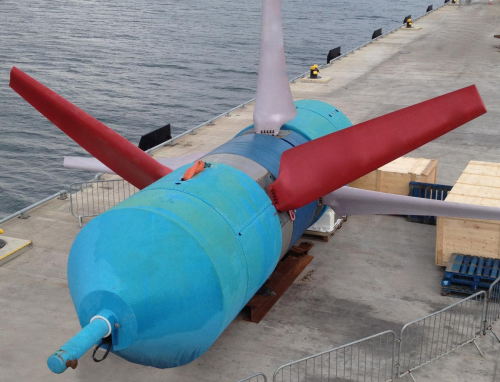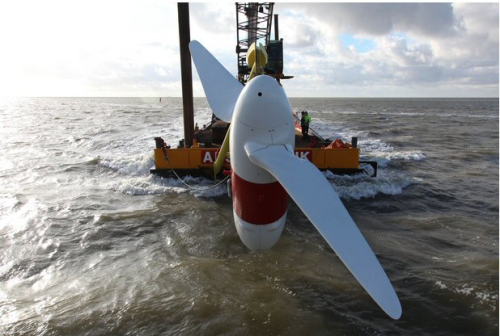

A new industry
Reinforced Plastics (RP): What is the current status of the tidal energy industry?
Peter Coppens (PC): Currently there are some six major OEM device developers leading the pack:
- Alstom / Tidal Generation Ltd (TGL);
- Siemens / Marine Current Turbines (MCT);
- Andritz Hydro Hammerfest;
- Voith Ocean Energy;
- Atlantis Resources Ltd; and
- DCNS / Openhydro.
With the exception of DCNS / Openhydro (which has an open-centre turbine technology), these companies are developing the so-called HAT turbine (horizontal axis turbine).
The tidal energy industry is in its infancy. Demonstrators have to prove the technology works and harbours sufficient potential to build the first pilot tidal farms ranging between 5-10 MW, producing energy for about 5000-10,000 homes.
All the above mentioned OEMs have 1 MW demonstrators in the water, or are about to put them into the water. The goal is to have pilot tidal farms operating in the 2016 period, however one depends on the performance on the currently deployed demonstrators.
In addition, there are many other companies such as Nautricity Ltd and Tocardo with slightly different concepts and different target markets.
In the end it is about achieving as low as possible cost of energy (CoE) and this will determine the winners.
In Europe, the potential for tidal energy is huge for both France and the UK/Scotland with respect to building a new (renewable) energy industry and the creation of thousands of jobs. Currently, funding of the industry is uncertain as risks cannot be quantified perfectly (since the technology and market is just emerging). This, combined with the UK's Electrical Market Reform, in essence stopped a lot of activities in their tracks. Luckily, on 4 December, the UK government published strike prices for renewable energies, which one can hope will give the industry a much needed push forward in 2014.
In France, that push is certainly underway as the French Government has designated sites at Raz Blanchard near Cherbourg and the Passage du Fromveur off the coast of Brittany for the first seven tidal pilot farms, each some 5-10 MW and with roughly a €120 million support scheme facilitating this. The call related to this endeavour is closing at the end of April. The ‘winners’ for the pilot tidal sites will be announced in September and the work can start.
Tidal blade design
RP: What are the requirements for tidal turbine blades? How does their design differ from wind turbine blades?
PC: The current tidal designs are very much copied from the wind blades, but they are now evolving as the environment of tidal blades is very different from that of wind blades. Simply put, the density of water is 1000 times higher than the density of air, thus the forces on tidal blades are immense.
One effect of this which can be seen clearly is that tidal blades are much 'fatter' (thicker) than wind turbine blades.
Tidal blades have to withstand the enormous forces of tidal water flows and (freak) turbulence flows, and must withstand water ingress and saturation as best as possible. Sea growth must be addressed as well as possible cavitation issues, which could potentially destroy blades within days. Tidal blades must also resist corrosion; this is not an issue for composites, but it is for metal blades (of which there are a few).
The demand for long maintenance intervals for tidal blades (3-5 years) are more severe than wind blades, as simple servicing of blades is not possible and quite expensive. Robust engineering and manufacturing is of the essence. This in itself poses a challenge as the tidal blades are currently all prototypes and no standardisation regarding manufacturing, testing or (tidal proven) engineering design codes is present.
Manufacture for long life
RP: How are Airborne’s tidal blades manufactured?
PC: Airborne’s blades are manufactured by vacuum-assisted resin transfer moulding (VA-RTM). They do not follow the wind blade shell design which needs to be bonded, encapsulates a spar and is based on the classic vacuum infusion process. We use epoxy resin reinforced with glass or carbon fibre non-crimp fabrics, or a hybrid of the two, depending on the blade specifications.
Airborne believes that in order to be as reliable and robust as possible, and have the promise of efficient mass manufacturing, adhesive bonds should be avoided. This is because it is not known how these adhesive bonds will perform in this application over a long period of time.
Airborne uses a monocoque concept, thus eliminating the need for adhesive bonding. Loads induced by the tidal stream are carried by the thick skin and are transferred through this, on both sides, to the root-hub connection, thus also eliminating a spar.
The blades must capture as much energy as possible from the tidal currents.Airborne uses an embedded insert technology for the root-hub connection to facilitate the transfer of structural loads. The company is also working on flexible (adaptive) blade designs designed to capture more energy from strong tidal flows without the need for (expensive) pitch control mechanisms.
Another area of development involves the integration of optical fibres within the blade laminate. This would make it possible to predict maintenance intervals and at the same time obtain very needed feedback on the structural thus engineering design assumption one simply needs to make at this point in time.
Airborne
RP: How does the tidal turbine blade business fit into Airborne International’s overall strategy?
PC: Airborne International develops composite products for the oil and gas, aerospace and marine industries. We focus on the development and implementation of scalable automated production technologies. Our first success has been the development of continuous spoolable fibre reinforced thermoplastic pipe for the subsea oil and gas market. Our goal is to become a partner for OEMs and Tier 1 suppliers, co-developing and producing composite solutions on an industrial scale.
NautricityScottish tidal technology developer Nautricity Ltd is in the process of deploying its CoRMat tidal turbine at the European Marine Energy Centre (EMEC) in Scotland, the world’s largest wave and tidal test centre. The CoRMaT turbine employs two closely spaced contra rotating rotors, driving a contra rotating electrical generator. The first rotor has three blades rotating in a clockwise direction. The second rotor, located directly behind the first, has four blades rotating in an anti-clockwise direction. The turbine is connected to a tensioned mooring. Airborne Marine developed and supplied the blades for the CoRMat turbine. In recent structural testing of the blades, both the composite blade and embedded root insert performed better than the design brief. Nautricity and Argyll Tidal Ltd have been given the go-ahead for an investigation into the possibility of locating up to six Nautricity 500 kW CoRMat tidal turbines in the waters off the Mull of Kintyre, Scotland, that would generate enough electricity to supply 2,700 homes. TocardoTocardo, headquarted in the Netherlands, offers turbines in the range of 100-1000 kW. The smaller turbines are suitable for river currents or inshore tidal currents; the larger turbines are designed for offshore tidal currents. In 2013, the Tocardo T100 turbine was tested in real life conditions in the Wadden Sea, the Netherlands, and both the turbine and composite blades, which are manufactured by Airborne Marine, demonstrated excellent performance. As part of the Tocardo turbine development programme the T100 blades are tested to the limit at the Knowledge Centre Wind Turbine Materials and Constructions (WMC) in the Netherlands with the support of Airborne Composites. Results are used to further optimise the blade and manufacturing process. In tests, the one-shot RTM composite blade has successfully gone through its 20 year design life cycle loads. |
The Marine business unit, created in 2013, will focus on heavy loaded submerged composite structures, which we believe will be needed to meet the future demands of the deepsea mining, deepsea offshore and LNG markets.
Tidal blades are a perfect match to the strategic intentions of Airborne International. ♦




